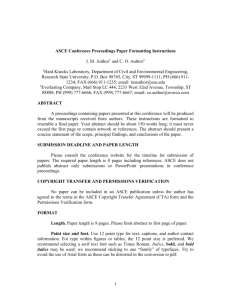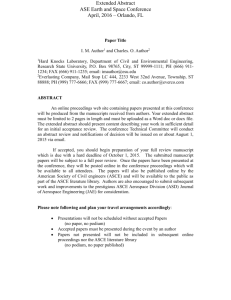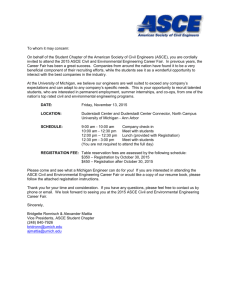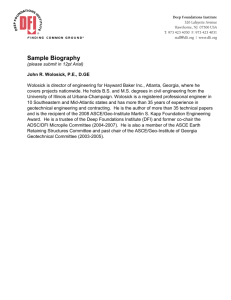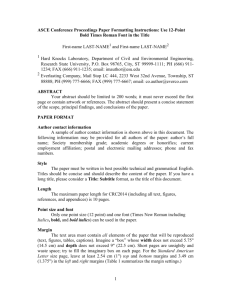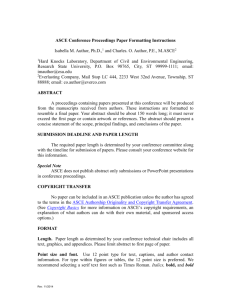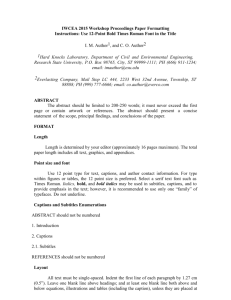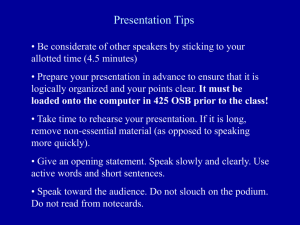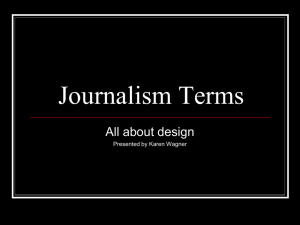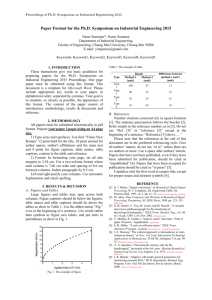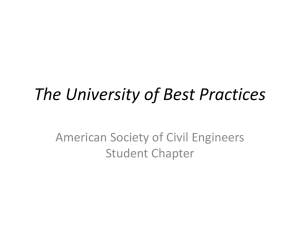IAHR Congress Paper Formatting Guide
advertisement
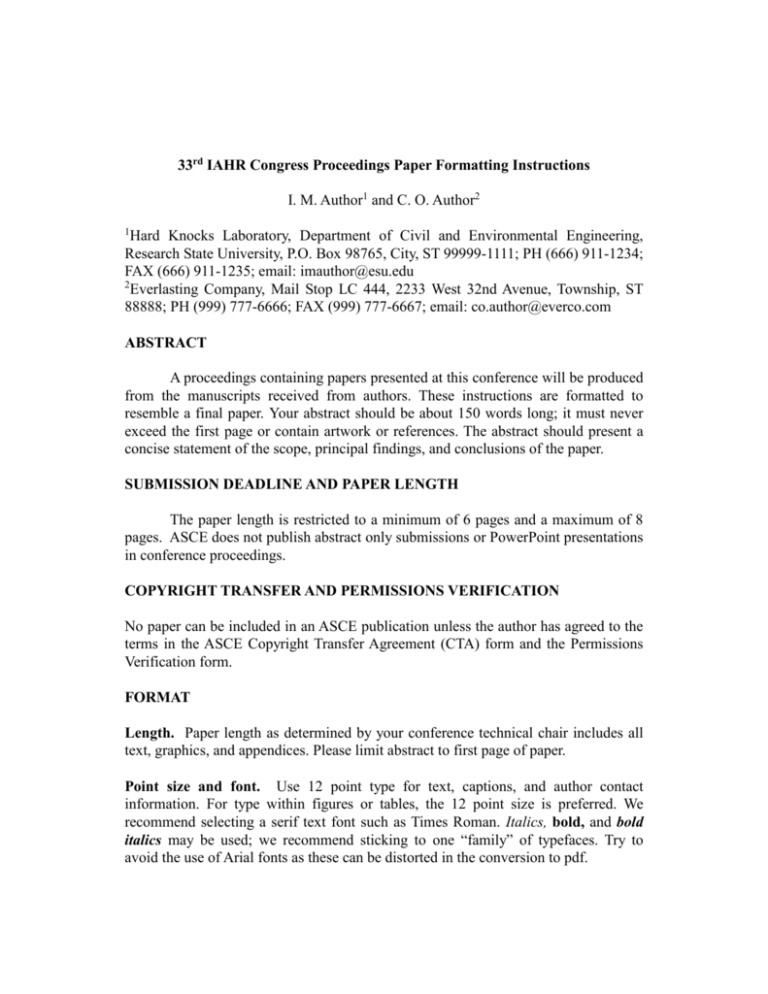
33rd IAHR Congress Proceedings Paper Formatting Instructions I. M. Author1 and C. O. Author2 1 Hard Knocks Laboratory, Department of Civil and Environmental Engineering, Research State University, P.O. Box 98765, City, ST 99999-1111; PH (666) 911-1234; FAX (666) 911-1235; email: imauthor@esu.edu 2 Everlasting Company, Mail Stop LC 444, 2233 West 32nd Avenue, Township, ST 88888; PH (999) 777-6666; FAX (999) 777-6667; email: co.author@everco.com ABSTRACT A proceedings containing papers presented at this conference will be produced from the manuscripts received from authors. These instructions are formatted to resemble a final paper. Your abstract should be about 150 words long; it must never exceed the first page or contain artwork or references. The abstract should present a concise statement of the scope, principal findings, and conclusions of the paper. SUBMISSION DEADLINE AND PAPER LENGTH The paper length is restricted to a minimum of 6 pages and a maximum of 8 pages. ASCE does not publish abstract only submissions or PowerPoint presentations in conference proceedings. COPYRIGHT TRANSFER AND PERMISSIONS VERIFICATION No paper can be included in an ASCE publication unless the author has agreed to the terms in the ASCE Copyright Transfer Agreement (CTA) form and the Permissions Verification form. FORMAT Length. Paper length as determined by your conference technical chair includes all text, graphics, and appendices. Please limit abstract to first page of paper. Point size and font. Use 12 point type for text, captions, and author contact information. For type within figures or tables, the 12 point size is preferred. We recommend selecting a serif text font such as Times Roman. Italics, bold, and bold italics may be used; we recommend sticking to one “family” of typefaces. Try to avoid the use of Arial fonts as these can be distorted in the conversion to pdf. Layout. All text must be single-spaced. Page design should be consistent throughout the paper. Margin settings (see below) must contain all elements of the paper that will be reproduced (text, figures, tables, captions). Imagine a “box” whose width does not exceed 5.75" (14.5 cm) and depth does not exceed 9" (22.5 cm). Short pages are unsightly and waste space; try to fill the imaginary box on each page. Leave at least 1" (3 cm) top and bottom margins. The first page of the paper should be an additional .5" below the top margin. Table 1. Margin Settings. 8.5 x 11 (letter) A4 1" 1" 1.375" 1.375" 3.5 cm 3.5 cm 3.25 cm 3.25 cm Margins Top Bottom Left Right Figures and tables. All graphics (photos, line art, and tables) must fit within the above margin settings. All graphics should be understandable when printed in black and white. Do not use only color as a distinguishing feature. Use symbols or patterns on line and bar graphs to identify lines and columns. Landscape orientation is acceptable. Illustrations should be numbered consecutively as they are presented (Figure 1, Figure 2, etc., and Table 1, Table 2, etc.). Each figure should be mentioned or called out before it appears. More than one figure may appear on a page. Captions and legends. A descriptive caption, including figure number, should be placed directly below the illustration (see Figure 1). A descriptive legend, including table number, should be placed immediately above the table (see Table 1). Figure 1. Sample line art illustration. Style. The paper must be written in the best possible technical and grammatical English. Titles should be concise and should describe the content of the paper. If you have a long title, please consider a Title: Subtitle format. Mathematics. All mathematics must be embedded in the text. Equations need to be numbered only if they are referred to more than once. System of units. For more information about SI units, go to the U.S. Metric Association (USMA), Inc. site (http://lamarcolostate.edu/%7Ehillger/) or the National Institute of Standards and Technology (NIST) site (http://physics.nist.gov/cuu/Units/index.html). Author contact information. A sample of author contact information is shown on the first page of these instructions. The following information may be provided for all authors of the paper: author’s full name; Society membership grade; academic degrees or honorifics; current employment affiliation; postal and electronic mailing addresses; phone and fax numbers. References. All references should appear together at the end of the paper (see below). References are listed alphabetically by last name of the first author. When two or more references by the same author are listed, year of publication is taken into account, and the earliest work is listed first. Wherever reference is made in the text to an author’s work, the author’s name and year of publication should appear in parentheses. We strongly recommend that superscripts not be used to denote references, as these numbers often appear too small to be read easily. All listed references must be cited in text. See samples below. PERMISSIONS If a figure, photograph, or table has been published previously, the author must obtain written approval from the original publisher. APPROVALS It is the author’s responsibility to obtain all necessary approvals from the author’s employer prior to submission of the paper. Once a paper has been uploaded, reviewed by the author, and officially submitted, it is not possible to edit the document. CONCLUSION With thanks for your efforts, we look forward to providing a record of this conference that will be useful to you and your colleagues for many years to come. REFERENCES Burka, L. P. (1993). “A hypertext history of multi-user dimensions.” MUD history, http://www.ccs.neu.edu/home/lpb/mud-history.html>(Dec. 5, 1994). Fisher, J. W., and Struik, J. H. A. (1974) Guide to design criteria for bolted and riveted joints, Wiley, New York. International Conference of Building Officials (ICBO). (1997). Uniform building code, Whittier, Calif. Kurtz, M. (1991). “Section 7: Transformation of space in computer graphics.” Handbook of applied mathematics for engineers and scientists, McGraw-Hill, New York, 7.1-7.42. Mossberg, W. S. (1993). “Word isn’t perfect but new WordPerfect is too much for words.” Wall Street J., Dec. 2, B1 Pennoni, C.R. (1992). “Visioning: The future of civil engineering.” J. Profl. Issues in Engrg. Educ. And Pract., ASCE, 118(3), 221-233.
